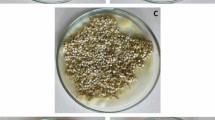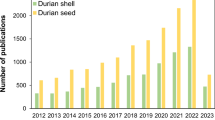Abstract
Avenanthramides (AVNs), free and bound phenols and their antioxidant capacities (ORAC) were evaluated in two Avena sativa L. cultivars, Donata and Flavia. The cultivars (cvs.) were grown in loamy and medium texture soils and assessed after industrial dehulling and milling. Total dietary fiber, β-glucan, starch and proteins were also evaluated. Cv. Donata showed 2.8 fold higher AVN storage as compared to cv. Flavia, which was linked with genotype. The accumulation of AVN content was also influenced by the texture of the soil. Dehulling resulted in a 75 and 37% AVN decrease in cv. Donata and Flavia, respectively. The dehulled grains of cv. Donata showed 40% reduction in free phenolic content, whereas the dehulled grains of both cvs. showed 67% reduction in bound phenols. Milling affected the bound phenolics and their antioxidant capacity. Cv. Flavia showed 1.3 fold higher β-glucan than that of cv. Donata. Total dietary fiber was reduced by 50 and 12% after dehulling and milling, respectively, while marginal changes in proteins were observed after milling. The results suggest that the choice of genotype and the kind of dehulling processes that are employed are essential considerations in the production of oat-based products with high AVN content and extra health benefits.


Similar content being viewed by others
Abbreviations
- AVNs:
-
Avenanthramides
- BPs:
-
Bound polyphenols
- CAE:
-
Caffeic acid equivalents
- cvs.:
-
Cultivars
- d.w.:
-
Dry weight
- EFSA:
-
European Food Safety Authority
- FAE:
-
Ferulic acid equivalents
- FPs:
-
Free polyphenols
- ORAC:
-
Oxygen radical absorbance capacity
- SD:
-
Standard deviation
- TE:
-
Trolox equivalents
- TPs:
-
Total polyphenols
- Trolox:
-
6-Hydroxy-2,5,7,8-tetramethylchroman 2-carboxylic acid
- 2c:
-
N-(3,4-Dihydroxy)-(E)-cinnamoyl-5-hydroxyanthranilic acid
- 2p:
-
N-(4-Hydroxy)-(E)-cinnamoyl-5-hydroxyanthranilic acid)
- 2f:
-
N-(4-Hydroxy-3-methoxy)-(E)-cinnamoyl-5-hydroxyanthranilic acid
References
Andreasen MF, Kroon PA, Williamson G, Garcia-Conesa MT (2001) Intestinal release and uptake of phenolic antioxidant diferulic acids. Free Radical Bio Med 31:304–314
Antonini E, Lombardi F, Alfieri M, Diamantini G, Redaelli R, Ninfali P (2016) Nutritional characterization of naked and dehulled oat cultivar samples at harvest and after storage. J Cereal Sci 72:46–53
Bratt K, Sunnerheim K, Bryngelsson S, Fagerlund A, Engman L, Andersson RE, Dimberg LH (2003) Avenanthramides in oats (Avena sativa L.) and structure-antioxidant activity relationships. J Agric Food Chem 51:594–600
Cho SS, Qi L, Fahey GC, Klurfeld DM (2013) Consumption of cereal fiber, mixtures of whole grains and bran, and whole grains and risk reduction in type 2 diabetes, obesity, and cardiovascular disease. Am J Clin Nutr 98:594–619
Clemens R, van Klinken B (2014) Oats, more than just a whole grain: an introduction. Br J Nutr 112:S1–S3
Collins FW (1989) Oat phenolics: avenanthramides, novel substituted N-cinnamoylanthranilate alkaloids from oat groats and hulls. J Agric Food Chem 37:60–66
Dimberg LH, Sunnerheim K, Sundberg B, Walsh K (2001) Stability of oat avenanthramides. Cereal Chem 78:278–281
Doehlert DC, Moore WR (1997) Composition of oat bran and flour prepared by three different mechanisms of dry milling. Cereal Chem 74:403–406
Doehlert DC, Wiesenborn DP, McMullen MS, Ohm JB, Riveland NR (2009) Effects of impact dehuller rotor speed on dehulling characteristics of diverse oat genotypes grown in different environments. Cereal Chem 86:653–660
European Commission (2007) Council Regulation (EC) No. 834/2007 of 28 June 2007 on organic production and labelling of organic products and repealing Regulation (EEC) No 2092/91. Off J Eur Union L 189:1–23
European Commission (2012) Commission Regulation (EU) No. 432/2012 of 16 May 2012 establishing a list of permitted health claims made on foods, other than those referring to the reduction of disease risk and to children’s development and health. Off J Eur Union L 136:1–40
Hu XZ, Wei YM, Ren CZ, Zhao J (2009) Relationship between kernel size and shape and lipase activity of naked oat before and after peeling treatment. J Sci Food Agric 89:1424–1427
Jastrebova J, Skoglund M, Nilsson J, Dimberg LH (2006) Selective and sensitive LC–MS determination of avenanthramides in oats. Chromatographia 63:419–423
Kaur J, Kaur A, Aggarwal P (2014) Dehulling characteristics of oat (OL-9 variety) as affected by grain moisture content. Int J Res Eng Technol 3:109–113
Li H, Qiu J, Liu C, Ren CZ, Li ZG (2014) Milling characteristics and distribution of phytic acid, minerals, and some nutrients in oat (Avena sativa L.). J Cereal Sci 60:549–554
Masisi K, Beta T, Moghadasian MH (2016) Antioxidant properties of diverse cereal grains: a review on in vitro and in vivo studies. Food Chem 196:90–97
Meydani M (2009) Potential health benefits of avenanthramides of oats. Nutr Rev 67:731–735
Ninfali P, Mea G, Giorgini S, Rocchi M, Bacchiocca M (2005) Antioxidant capacity of vegetables, spices and dressings relevant to nutrition. Br J Nutr 93:257–266
Ninfali P, Diamantini G, Lombardi F, Antonini E, Nanni G, Pierini L, Mezzolani A, Redaelli R (2015) Oat germoplasm for food: quality characteristics in naked and husked cultivars. In: Aquistucci R, Blandino M, Carcea M, D’Egidio MG, Iametti S, Marconi E, Marti A, Pagani MA, Palumbo M, Redaelli R (eds) Grains for feeding the world, 10th AISTEC conference. AISTEC—Italian Association for Cereal Science and Technology, Rome, p 356–359
Ou BX, Chang T, Huang DJ, Prior RL (2013) Determination of total antioxidant capacity by oxygen radical absorbance capacity (ORAC) using fluorescein as the fluorescence probe: first action 2012.23. J AOAC Int 96:1372–1376
Panato A, Antonini E, Bortolotti F, Ninfali P (2017) The histology of grain caryopses for nutrient location: a comparative study of six cereals. Int J Food Sci Technol 52:1238–1245
Peterson DM (2001) Oat antioxidants. J Cereal Sci 33:115–129
Rasane P, Jha A, Sabikhi L, Kumar A, Unnikrishnan VS (2015) Nutritional advantages of oats and opportunities for its processing as value added foods—a review. J Food Sci Technol Mysore 52:662–675
Redaelli R, Scalfati G, Ciccoritti R, Cacciatori P, De Stefanis E, Sgrulletta D (2014) Effects of genetic and agronomic factors on grain composition in oats. Cereal Res Commun 43:144–154
Redaelli R, Dimberg L, Germeier CU, Berardo N, Locatelli S, Guerrini L (2016) Variability of tocopherols, tocotrienols and avenanthramides contents in European oat germplasm. Euphytica 207:273–292
Singh R, De S, Belkheir A (2013) Avena sativa (Oat), a potential neutraceutical and therapeutic agent: an overview. Crit Rev Food Sci 53:126–144
Singleton VL, Orthofer R, Lamuela-Raventos RM (1999) Analysis of total phenols and other oxidation substrates and antioxidants by means of folin–ciocalteu reagent. Oxid Antioxid Pt A 299:152–178
van der Kamp JW, Poutanen K, Seal CJ, Richardson DP (2014) The HEALTHGRAIN definition of ‘whole grain’. Food Nutr Res. doi:10.3402/fnr.v58.22100
Verardo V, Serea C, Segal R, Caboni MF (2011) Free and bound minor polar compounds in oats: different extraction methods and analytical determinations. J Cereal Sci 54:211–217
Wang Q, Ellis PR (2014) Oat ß-glucan: physico-chemical characteristics in relation to its blood-glucose and cholesterol-lowering properties. Br J Nutr 112:S4–S13
Wang RH, Koutinas AA, Campbell GM (2007) Dry processing of oats—application of dry milling. J Food Eng 82:559–567
Wise ML (2011) Effect of chemical systemic acquired resistance elicitors on avenanthramide biosynthesis in oat (Avena sativa). J Agric Food Chem 59:7028–7038
Yang J, Ou BX, Wise ML, Chu YF (2014) In vitro total antioxidant capacity and anti-inflammatory activity of three common oat-derived avenanthramides. Food Chem 160:338–345
Ye EQ, Chacko SA, Chou EL, Kugizaki M, Liu SM (2012) Greater whole-grain intake is associated with lower risk of type 2 diabetes, cardiovascular disease, and weight gain. J Nutr 142:1304–1313
Acknowledgements
The authors wish to thank Dr. Francesco Torriani and Dr.ssa Germana Meliffi from the CERMIS Consortium Marche Bio and Terra Bio Soc., Schieti di Urbino (The Marches, Italy) for supplying oat samples; the Marches Region is acknowledged for financial support (Misura 1.2.4. “Cooperazione per lo sviluppo di nuovi prodotti, processi e tecnologie’’); Dr.ssa Daniela Sgrulletta from CRA-QCE for protein and fiber analysis; Dr. Simone Sartorelli from Lameri spa (Cremona, Italy) for dehulling and Massimo Fiorani from Prometeo srl (Urbino, Italy) for milling. The contributes of Mr. Timothy Bloom during the preparation of the English manuscript and of Dr. Michele Menotta for the statistic analysis were greatly appreciated.
Author information
Authors and Affiliations
Corresponding author
Electronic supplementary material
Below is the link to the electronic supplementary material.
Rights and permissions
About this article
Cite this article
Antonini, E., Diamantini, G. & Ninfali, P. The effect of mechanical processing on avenanthramide and phenol levels in two organically grown Italian oat cultivars. J Food Sci Technol 54, 2279–2287 (2017). https://doi.org/10.1007/s13197-017-2665-x
Revised:
Accepted:
Published:
Issue Date:
DOI: https://doi.org/10.1007/s13197-017-2665-x




